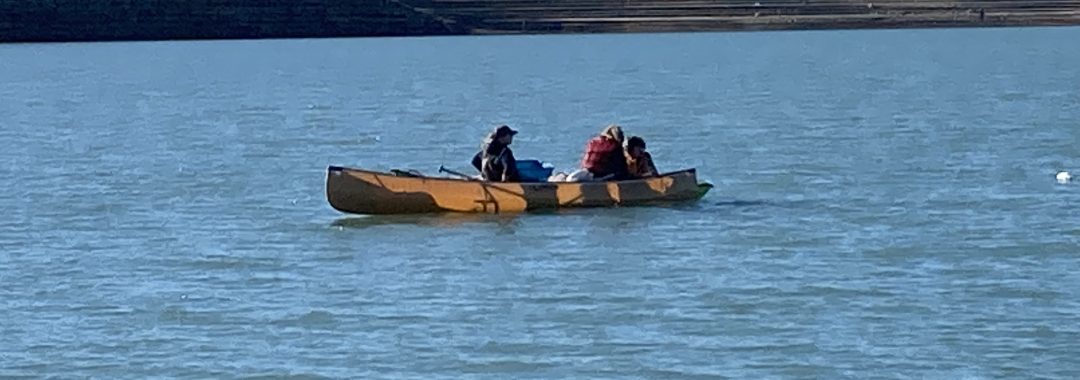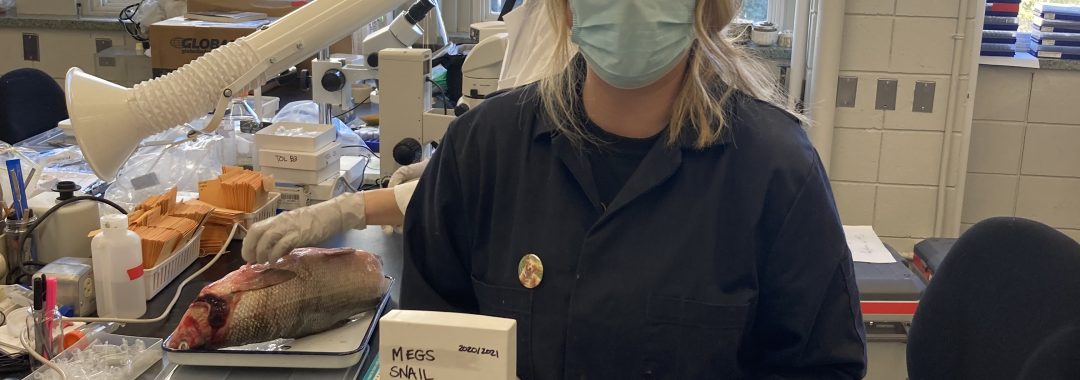Thesis Title: The introduction of Cipangopaludina chinensis and tropic effects of sympatric freshwater fish invaders in southern Alberta reservoirs.
Author: Megan Edgar
Abstract
At present, one of the most pervasive risks to freshwater ecosystems are invasive species. Invasive species are among the leading antagonists to global biodiversity, since they can out-compete or predate on native species which leads to changes of the structure of food webs and alteration of ecosystem function. As biogeographic boundaries are broken down by human-related means of spread, more are we seeing novel occurrences between non-native species and the ecosystems they are introduced to. As invasive species continue to radiate from their original regions, it is critical to understand how these species will impact their new ecosystems. As of 2019, non-native Chinese Mystery Snail (Cipangopaludina chinensis (Gray, 1834)) has persisted in McGregor Lake Reservoir, Alberta, Canada. Additionally, Northern Crayfish (Faxonius virilis) a non-native species which has expanded their range into lakes and rivers in Alberta, exists in sympatry with Chinese Mystery Snail in McGregor Lake Reservoir.
I aimed to advise management programs related to both Chinese Mystery Snail and Northern Crayfish in Alberta lakes and reservoir systems, and provide important information regarding the trophic interactions and outcomes to native recreational fish species (Northern Pike (Esox lucius), Walleye (Sander vitreus), and Lake Whitefish (Coregonus clupeaformis)).
In this thesis, I provide a comprehensive literature review regarding Chinese Mystery Snail in Canada, along with pertinent information regarding their impacts, life history characteristics, morphological characteristics, and range within invaded and native ranges. The initial finding of Chinese Mystery Snail is officially documented in Alberta, along with biological information that may aid management efforts. DNA barcoding is used to confirm the species identification and the barcode is added to GenBank. We analyze growth rate and fecundity, and assessed the presence of digenean trematode cercariae in snails in McGregor Lake Reservoir. After a 24-hour experimental period, we confirmed that Chinese Mystery Snail specimens are not infected by digenean trematodes. We also determine that shell growth quickly outpaces shell width, and that upon emergence Chinese Mystery Snail is larger than many of the native snail species in Albertan waterbodies. We also determine that Chinese Mystery Snail in Alberta produce a lower average number of juveniles compared to populations elsewhere. We also suggest that Chinese Mystery Snail meet four of the five stages of species invasion: arrival, establishment, growth, and reproduction, however there is no evidence of dispersal to adjacent waterbodies.
With the use of stable isotope analysis and gut content analysis, I address the trophic consequences that may arise with the addition of Northern Crayfish and Chinese Mystery Snail into aquatic ecosystems in southern Alberta, as well as their impacts to Northern Pike, Walleye and Lake Whitefish. I sampled five reservoirs in Alberta (St. Mary’s Reservoir, Forty-Mile Reservoir, Sherburne Lake Reservoir, Travers Lake Reservoir, and McGregor Lake Reservoir), collecting macrophytes, benthic macroinvertebrates, small-bodied fish species, as well as invasives and large recreational fish species. I hypothesized that the presence of only one aquatic invader would create bottom-up effects on the food-web, and that an additional invasive species would amplify these effects, creating shifts in fish trophic positions by moving basal energy away from higher trophic levels through the consumption of algae and macrophytes, or by providing a new prey resource. I also hypothesized that Chinese Mystery Snail and Northern Crayfish would have overlapping niches, through competition for resources or predation. Briefly, I determined that fish are becoming more piscivorous compared to reference lakes where there are no invasive species present, community trophic positions are higher in reservoirs where only Northern Crayfish are present as an invasive, and that carbon ranges are narrower in systems with only Northern Crayfish and wider when both invasives are in sympatry. A few reasons that these effects may be occurring to fish include an “adaptive lag” period, or lack of macrophytes in invaded waterbodies due to the invasives present. I also discovered that trophic niche ellipses of Chinese Mystery Snail and Northern Crayfish are overlapping, pointing to competitive exclusion.
The results from this thesis address my overall goals to investigate the introduction of Chinese Mystery Snail and the potential impacts of interactions between Chinese Mystery Snail and Northern Crayfish on native recreational fish species in reservoirs in southern Alberta. The findings gained throughout this thesis are useful for the management of both invasive species and will hopefully provide a catalyst for other researchers and resource managers.



